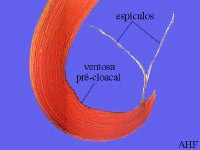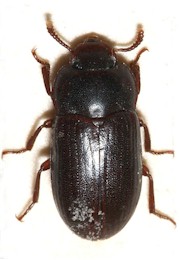Subulura is a genus of parasitic roundworms that infects chickens, turkeys, pigeons, guinea fowls, ducks, pheasants, quails, etc. as well as numerous wild birds.
that infects chickens, turkeys, pigeons, guinea fowls, ducks, pheasants, quails, etc. as well as numerous wild birds.
These worms are not as frequent as other gastrointestinal roundworms of poultry (e.g. Ascaridia spp, Capillaria spp, Heterakis spp), but prevalence can be higher than 50%.
The most relevant species for poultry are:
- Subulura brumpti = Subulura suctoria = Allodapa suctoria is found worldwide, and is the most frequent species of this genus.
- Subulura differens is found mainly in America, Southern Europe and Africa in chicken and guinea fowls.
- Subulura gallopavonis is found mainly in Europe in chicken.
- Subulura strongylina is found mainly in America in chicken and guineafowl.
These species do not affect dogs, cats, cattle sheep, goats, swine or horses, but there are a few species than can also infect mammals.
The disease caused by Subulura worms is called subulurosis.
Are birds infected with Subulura worms contagious for humans?
- NO: The reason is that these worms are not human parasites.
You can find additional information in this site on the general biology of parasitic worms and/or roundworms.
Final location of Subulura worms
Predilection site depends on the species:
- Subulura brumpti, Subulura gallopavonis, Subulura strongylina: cecum
- Subulura differens: small intestine
Anatomy of Subulura worms
Adult Subulura worms are up to 30 mm long, whereby females are larger than males. The posterior end is often coiled upwards. The buccal sapsules has three teeth.
As in other roundworms, the body of these worms is covered with a cuticle, which is flexible but rather tough. The worms have a tubular digestive system with two openings. The mouth has three lips. Males have a characteristic sucker close to the cloaca. They also have a nervous system but no excretory organs and no circulatory system, i.e. neither a heart nor blood vessels.
Each male has a bursa with two equal spicules for attaching to the female during copulation.
The eggs are oval, ~45x65 micrometers, have a thin shell and are embryonated when shed with the feces.
Life cycle of Subulura worms

These Subulura worms have indirect life cycles. Intermediate hosts are certain beetle (e.g. Alphitobius spp) and cockroach species.
Adult female worms lay embryonated eggs in the host's gut that are passed with the feces. Intermediate hosts ingest the eggs, which release the larvae a few hours later. These larvae complete development to infective L3 larvae in about 2 weeks and become encysted in the body of the intermediate host.
Birds become infected after eating contaminated beetles or cockroaches. Larvae are released after digestion and reach the predilection sie rather quickly, where they complete development to adult worms in about 2-3 week, depending on the species and the host.
The prepatent period of Subulura brumpti (time between infection and first eggs shed) is about 7 weeks.
Harm caused by Subulura worms, symptoms and diagnosis
These worms are usually not or only mildly pathogenic and most infections do not cause clinical signs. Nevertheless, heavy infections can diminish productivity in layer hens and broilers. These worms affect mainly birds kept outdoors under traditional farming conditions because they are more likely to eat contaminated beetles and cockroaches. Industrial poultry operations are usually free of these worms.
Diagnosis is based on detection of typical eggs in the feces (although species determination is often difficult) or on identification of the adult worms after necropsy. These worms are very similar to Heterakis spp and it is important to differentiate them.
Prevention and control of Subulura infections
To prevent or at least reduce Subulura infections it is recommended to keep the birds' bedding as dry as possible and to frequently change it, because survival of the worms' eggs needs humidity.
The use of insecticides to kill the intermediate hosts is not advisable: for cost-benefit reasons and because it is often very difficult to eliminate all beetles and cockroaches in poultry houses with insecticides.
Numerous classic broad spectrum anthelmintics are effective against Subulura worms, e.g. several benzimidazoles (albendazole, fenbendazole, flubendazole, mebendazole, oxfendazole, etc.), levamisole, as well as macrocyclic lactones (e.g. ivermectin).
For use on poultry these active ingredients are usually available as additives for feed or drinking water, seldom as injectables or tablets (mainly for single animal treatment, typical for fighting roosters). However, in some countries Subulura species may not be included in the label of wormers, because they are less frequent than other poultry roundworms (e.g. Ascaridia spp, Capillaria spp, Heterakis spp)
Most such wormers (e.g. benzimidazoles, levamisole, piperazine derivatives and pyrantel) kill the worms shortly after treatment and are quickly metabolized and/or excreted within a few hours or days. This means that they have a short residual effect, or no residual effect at all. As a consequence treated animals are cured from worms but do not remain protected against new infections. To ensure that they remain worm-free the animals have to be dewormed periodically, depending on the local epidemiological, ecological and climatic conditions.
So far no vaccine is available against Subulura worms. To learn more about vaccines against parasites of livestock and pets click here.
Biological control of Subulura worms (i.e. using its natural enemies) is so far not feasible.
You may be interested in an article in this site on medicinal plants against external and internal parasites.
Resistance of Subulura worms to anthelmintics
There are a no reports on confirmed resistance of Subulura worms to anthelmintics.
This means that if an anthelmintic fails to achieve the expected efficacy against Subulura worms it is most likely that either the product was unsuited for the control of these worms, or it was used incorrectly.
|
Ask your veterinary doctor! If available, follow more specific national or regional recommendations for Subulura control. |